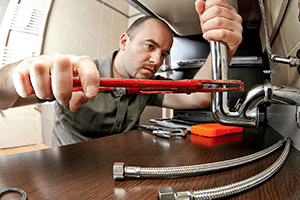Series on Safety: Plumbing

The most prevalent issue when it comes to cold weather and plumbing is frozen pipes. Don’t worry too much if the temps outside dip below freezing as pipes will not freeze until temps hold around 20º according to the University of Illinois Building Research Council. However, temperatures in the sub-zero range can put your pipes in danger. The easiest way to avoid freezing is insulation. Foam pipe insulation sleeves are available at most home improvement stores, and do the trick for exposed pipes in crawl spaces and attics. In addition, electrical tape can be wrapped around smaller sections of pipe to prevent freezing.
Another way to prevent frozen pipe problems is to maintain heat circulation throughout the house, including crawl spaces and attics. Any vents that let cold outside air into these spaces should be closed, and heat from the house will be allowed to radiate through them. This minimal heat can help to ensure the pipes don’t freeze through during an extended deep freeze.
In the event that your pipes do freeze, there are a few things you can do to prevent them from bursting or other pipe damage. First, turn off the water main to prevent issues after the ice melts. Second, turn on all faucets in the house, just enough so that they dribble. This allows the pressure to be released that can form in frozen pipes. Relieving this pressure can help ensure the expanding ice does not crack or burst your pipes. Lastly, if you want to try manually thawing the pipes, a hair dryer or other radiative source of heat can be used to slowly warm the frozen sections. Do not use an open flame or torch to thaw frozen pipes.
Should a pipe crack or burst, a drop in water pressure will be noticeable, and would indicate a problem somewhere in the line. The water main should be turned off immediately to avoid a constant flow of water through the pipes. Even a small crack can create immeasurable damage on your home, so if you notice a small leak or crack, call a plumber immediately and have the cracked section replaced. Even if you cannot see a crack or break, that does not mean it is not there. These problems can occur out of sight, so make sure to keep an eye out for any indications of the presence of water in walls, floors or your ceiling.
Be aware of the cold temperatures, and keep an eye on plumbing to keep your home safe and dry. If problems do arise, call a professional. Plumbing is not always something you can learn how to do on the internet, especially large repairs. Avoiding major water damage is a top priority when protecting your family and home. Vigilance when it comes to plumbing care and maintenance is the first defense when cold weather strikes.
